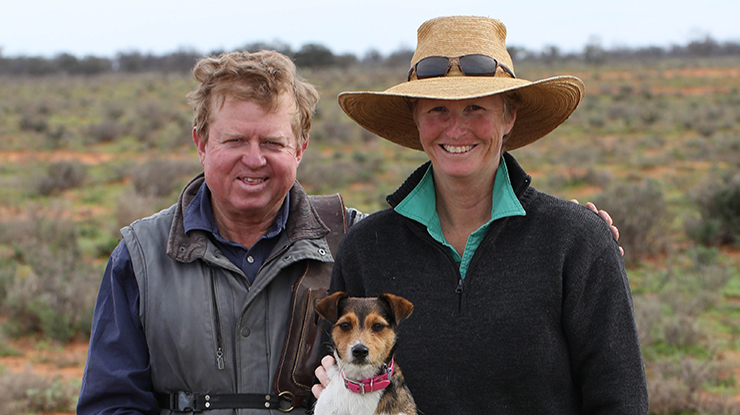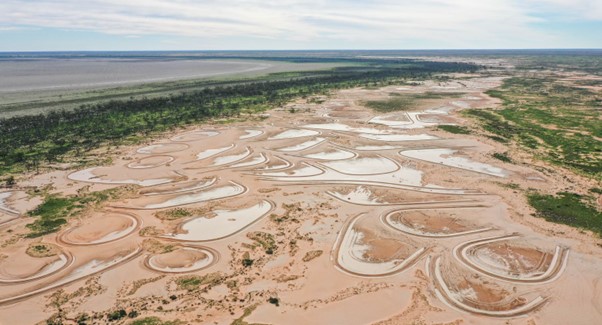
As part of the Rangelands Living Skin project, a group of NSW producers are running trials of low-cost, scalable practices that offer possible solutions to increase farm income and landscape function.
Gus and Kelly Whyte (pictured) are trialling water ponding as one strategy to repair and rehydrate their rangelands station near Wentworth.
Water ponding is a mechanical intervention, appropriate on gentle slopes, to slow the flow of water across the landscape and encourage water infiltration into the soil. This approach is used to reclaim scalded country and rehydrate rangeland landscapes.
The Whytes were keen to rehydrate a large-scaled area on their property. They accessed a Local Land Services (LLS) grant for $10,000 to undertake the water ponding project.
The Whytes contributed $5,000 and LLS provided the surveyor and directed and oversaw the contractor who constructed banks.
“Water ponding needs a fair bit of planning to make sure the banks are going in the right spot,” Gus said.
“Producers should do water ponding projects in conjunction with and under the instruction of someone who knows what they are doing.”
The whole water ponding project covers 300ha. In February 2022, the Whytes and LLS selected two sites within this area to monitor.

The ponds were created in Feb 2022. This drone footage was taken after a rainfall, nearly four months post construction. It shows the ability of the 30-plus ponds pictured here to slow the flow of water. Image: Brett Naseby.
Between February and June, a grader was used to construct more than 60 U-shaped earth banks, measuring 500mm high at their peak and 2m across at the bottom. Construction paused in April–May due to large rain events as constructing water ponds is much easier and long-lasting when done with dry soil.
The Whytes and collaborating scientists will monitor the water ponding works or three years, to map changes in soil, pasture, production and biodiversity. It will be compared with a control site (not ponded) and reference site (a paddock in good condition as it receives good water flow already).
The expectation is for the ponding trial areas to regenerate and, in time, look more like the reference site.
Influencing landscape
So far, Gus has observed that the ponds have retained a lot of water.
A year after construction began, the ponds are already influencing the landscape.
“There’s certainly an increased growth of saltbushes and other perennials in places where there were previously no plants,” Gus said.
The Whytes are also looking forward to the scientific studies with project partners to understand other types of soil and landscape change – such as soil carbon, water infiltration and microbiology – to better understand and explain the value of landscape and soil stewardship practices.
Senior Land Services Officer Paul Theakston said the Western LLS Rangeland Rehabilitation Program is also keen to see how this water ponding will reinstate natural surface water flows.
“Gus and Kelly’s project area originally would have acted like a ‘sponge’ with shallow ponds (called gilgais) absorbing water into the soil and excess water being slowly released as low-energy flows,” Paul said.
“Projects such as water ponding, water-spreading banks and diversion banks reinstate these natural water flows and landscape function.”
He hopes to see erosion and claypan rehabilitation projects on many properties in the rangelands.
Initial results from these trials will be published later this year.








